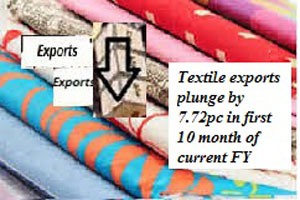
Pakistan textile exports plunge by 7.72pc in first 10 month of current FY
YarnsandFibers News Bureau 2016-05-23 11:00:00 – KarachiAs Pakistan’s local textile industry fails to invest in its modernization, lack of product diversity and diversification to explore new exports avenue, bringing it’s share in the international market down which has affected textile exports. In the first 10 months of the current fiscal year, textile exports has plunged by 7.72 percent to $10.395 billion, as per official data.
The Pakistan Bureau of Statistics (PBS) data showed that textile exports fetched $11.26 billion in the July-April period of the last fiscal year.
According to a World Bank’s report, issued in April, product diversity and availability is a key concern facing the country’s textile industry.
The country has specialty in basic cotton, woven, denim and chino trousers, low-priced knitwear, such as polo shirts and T-shirts, and fleece sweatshirts.
The report mentioned the limited availability of manmade fiber- (MMF) based products and barriers to MMF textile imports as some of the key concerns.
One way to increase product diversity and move away from cotton-based apparel is to reduce barriers on imports to ease access to MMFs. They could attract global buyers and investors by adopting policies to reduce red-tape and increase transparency.
The bank said that the country’s exports are increasing at a higher rate than the world average, but Bangladesh enjoys the largest increase in global market share in south Asia region.
The report said that many buyers avoid Pakistan because of the security situation and hence entrepreneurs have to travel to Dubai to meet them, which complicates sourcing. Also Sri Lanka has outshined both India and Pakistan in EU’s textile market, although the latter two, are the big winners for U.S. market.
An official, associated with the world biggest retail chain Wal Mart, said that the industry couldn’t able to benefit from the European Union’s generalized system of preferences (GSP) plus status to Pakistan.
An analysis said that the country’s exporters are losing competitiveness in the international markets as the industry, accounting for nine percent to GDP and more than 60 percent of exports, is facing liquidity crunch.
In April, textile exports increased 3.07 percent to $1.033 billion over March, but they decreased 3.48 percent over the same month a year ago.
The PBS data showed that exports of raw cotton, cotton yarn, cotton cloth, knitwear and bed wear fell 47 percent, 32 percent, 9.89 percent, 1.91 percent and 4.34 percent, respectively in July-April 2015/16.
Exports of readymade garments and towels rose 4.87 percent and 0.37 percent, respectively in the period under review.
Total exports declined 12.99 percent to $17.322 billion in the first 10 months of the current fiscal year while imports of raw cotton, synthetic fibre, worn clothing and others surged 27 percent to $2.663 billion, as per PBS data.
Market Intelligence
Ask for free sample Report

experience
Customer Base
dedicated team
Countries Served Worldwide









